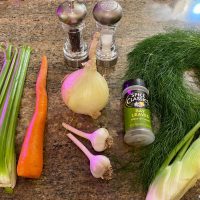UW Farm Weekly Dirt: Zucchini Overload

If I asked you, “what is the most prolific summer crop in your garden” what would you answer? My guess is zucchini.
Last year, the UW Farm grew over 3,000 pounds of zucchini from only 5 beds (250 total bed feet), despite powdery mildew, smoke-filled skies and a record wet spring. That’s a lot of zucchini bread, zucchini Parmesan, and zucchini noodles.
UW Farm’s Weekly Dirt: Focus on Fennel

A licorice fragranced vegetable may seem like a strange combination, unless you have come across fennel, the whole plant, feathery frond and bulging stem. As it turns out, this aromatic perennial (or annual depending on your climate) in the carrot family has a fascinating history, playing a medicinal and even mystical role in our culture since ancient times.
As a commercial farmer years ago, I explored growing fennel to appeal to high-end restaurant chefs, In the last five years at the campus farm, I have learned that it is simple to grow, has many organic uses (beneficial insects love it!) and newly discovered recipes continue to pull me into its culinary orbit.
New leadership for UW Botanic Gardens announced

UW Botanic Gardens welcomes Dr. Christina Owen as Director, starting September 13, and School of Environmental and Forest Sciences Professor Dr. Josh Lawler as the new Faculty Director.
Read moreSelected Mid-Summer Cuttings from the WA Park Arboretum

1) Castanea dentata American Chestnut
American Chestnut once dominated many forests from Maine and southern Ontario to Mississippi and from the Atlantic coast to the Appalachian Mountains, and was once one of the most common trees in the northeastern United States.
American Chestnut suffered a catastrophic population collapse due to the chestnut blight, a disease caused by an Asian bark fungus (Cryphonectria parasitica).
How Virtual Programs Have Supported Our Community Over The Past Year

In March of 2020, in-person gatherings were shut down as the COVID-19 pandemic had just begun. Program offerings at our gardens and all over the world ceased, but the demand for educational opportunities only increased while people diligently stayed home. Flash forward two months, the UW Botanic Gardens offered our first ever adult education class on a virtual platform. Unsure of how the class would go, all 29 people registered for the previously planned in-person class “Gardening with the Seasons: Spring,” logged onto Zoom.
Read moreEarly Summer Selected Cuttings at the Washington Park Arboretum

1) Acer palmatum ‘Nuresagi’ Japanese Maple
Now that the vivid colors of the emerging foliage of Japanese Maples have faded, it is time to appreciate the summer beauty of the sometimes, very colorful samaras (winged achene containing the maple seed).
Not all Japanese Maples produce showy samaras, but some cultivars are known specifically for this.
Acer palmatum ‘Nuresagi’ (“nuresagi” translates to “wet heron”) is located at the edge of the Upper Woodland Garden Pond.
June 2021 Plant Profile: Salmonberry

As we look forward to the warmth of the summer, let’s take a moment to appreciate one of the first berries that ripens in our region – salmonberry. The scientific name is Rubus spectabilis and is appropriately named for its showy flowers and berries. The genus Rubus is derived from ruber, the Latin word for red, while spectabilis is Latin for spectacular, notable, or showy.
Read moreTrees of the Lagoon

The peninsula north of the Linden Parking Lot (#16) is sometimes referred to as the Lagoon. Enjoy these trees while walking, birding, viewing wildlife, or boating.
1) Nothofagus antarctica Antarctic Beech
This tree is native to southern Chile and Argentina.
A deciduous tree with shaggy bark and small glossy leaves can be found north of the canoe launch.
It was once believed to be the southernmost growing tree on Earth until 2019, when a Nothofagus betuloides was found on the same island just slightly further south on Hornos Island, Chile.
Spring is officially under way in the lovely Pacific Northwest!

Here’s a small peek at a few of the many plants here at the Washington Park Arboretum that are showing off their unique spring features.
1) Cercis canadensis Eastern Redbud
One can’t help but admire this small, often multi-stemmed flowering tree as its glowing, purple-pink buds break out in spring through early summer.
With stunning cultivars such as ‘Appalachian Red’ and ‘Forest Pansy’ being highlighted in botanic gardens and arboreta, popularity has soared over the past several decades.
